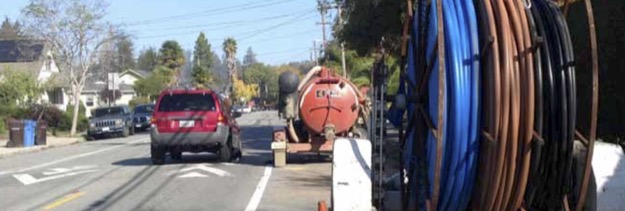
It’s one thing to say that empty telecoms conduit – shadow conduit – should be installed anytime a street is repaved or a utility trench is dug, but that begs a question: what kind of conduit, and how should it be designed?
To answer that question, the Monterey Bay Economic Partnership and the Central Coast Broadband Consortium convened a technical expert group that included senior public works engineers, Internet service providers, underground construction contractors and manufacturers. An intense discussion at an afternoon meeting at U.C. Santa Cruz produced a draft set of shadow conduit specifications and guidance, which then circulated through several rounds of revisions.
Consensus was reached on a number of key items, including appropriate conduit size…
- 2-inch conduit is sufficient for multiple high capacity fiber cables using current technology (432 strands or more), and can be subdivided using inner-duct that would allow multiple service providers to share a single conduit.
- 4-inch conduit has even more capacity but, due to its larger size, can present design problems, for example when connecting to vaults. This size of conduit was standard when telecommunications systems depended on thick bundles of copper cables, but is not necessary for most modern fiber applications. However, 4-inch conduit should be considered for installation on bridges, railroad crossings and in other circumstances where future changes would be particularly difficult or impossible.
- Smaller conduit, e.g. 1.25-inch, is useful when it is not possible to install 2-inch conduit or when many, separate conduits are installed. It may be preferred when conduits are expected to be used by a single service provider, rather than shared among many over time, or when it meets the needs of an anticipated project or service provider.
Other specs included vault and hand hole placement, conduit system design considerations and preferred installation locations.
The document is intended to guide shadow conduit design decisions, not dictate them. It represents the broad consensus of the expert group members, but actual designs will ultimately depend on the specific circumstances of any given project or jurisdiction.
The next subject that the MBEP/CCBC expert group plans to tackle is microtrenching. It’s a fiber installation technique that, on the one hand, reduces project costs, but on the other hand can impact street service life and maintenance costs.
